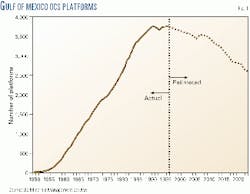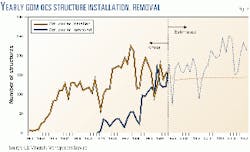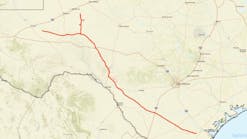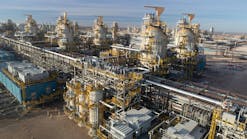As the world's producing basins continue to mature, oil and gas companies will have to face the various issues that surround the decommissioning and potential removal of their production platforms.
Arguably, the greatest advances in the processes involved in the decommissioning and removal of platforms have been made in the Gulf of Mexico's Outer Con tinental Shelf (OCS). For years, operators in the gulf have had to grapple with what to do with platforms once they've reached the end of their economic lives, all the while advancing into deeper waters.
In addition, advancements in technology have provided operators with a broader range of options for platform decommissioning and removal. Such technologies range from improved tools for cutting platforms apart-particularly through the use of explosives-to more efficient vessels for moving jackets, once severed.
International oil and gas companies are watching closely the accomplishments made in the gulf, which is currently serving as a "poster child," of sorts, for the decommissioning and removal process at a time when the number of production platforms is on the decline.
Platform decline
The number of oil and gas platforms operating in the gulf's OCS is expected to begin a measured, but continual, decline over the coming decades, according to a study prepared for the US Minerals Management Service by the Louisiana State University Center for Energy Studies (CES) earlier last year.
The forecast shows that the most likely scenario will be for the number of offshore structures operating in the gulf to diminish over the next quarter century by 29%.
"The plateau of about 3,600 structures that was reached and maintained during the 1990s is [both] a peakellipseand the drop-off period for the decline," CES said (Fig. 1).
The study-which projected the number of platforms to wane over a time period through 2023-reported that the 3,687 structures currently installed in the gulf would reach 2,612 by the end of the forecast period.
There is a multifaceted cause behind this decline, CES explained. "The decline will occur because the number of platforms being removed is predicted to increase significantly above current levels, while the number of platforms being installed is predicted to increase only slightly above current levels.
"As a consequence of this pattern... overall activity in removing and installing platforms increases significantly, despite the decline in the number of operating platforms during the forecast period."
The CES report went on to say that despite the anticipated decline in the number of structures, it did not expect the economies of nearby coastal areas to be negatively impacted. "Since many of the platforms installed are expected to be larger platforms located in deeper water further from shore, while more of the platforms forecast to be removed are smaller platforms located in shallower waters, expenditures on installing and operating new platforms and pipelines (as well as on removing old platforms) will dwarf expenditures lost as smaller platforms cease operating."
The rate of platform installations is expected to average 142/year through 2023, totaling 3,543 over the 25-year period. The platform removal rate during the same period is expected to average 186/year, totaling 4,645 structures. These figures are noteworthy, said CES, as they reflect a reversal of the gulf's typical installation-removal ratio, which would ordinarily show installations outpacing removals (Fig. 2).
The study's findings are significant for other reasons as well, CES noted. For years now, these offshore structures have provided an environment for reef-dwelling fish. Reefs are a phenomenon that do not occur naturally in many parts of the gulf. CES said, "A forecast of the number of platforms operating over the next 25 years will be useful to those responsible for planning, managing, and preserving fish habitat and fish stocks through artificial reefs and other management programs."
Other findings
A partial list of some other study findings follows:
- The number of platform installations is expected to remain relatively flat. The rate is expected to rise only slightly to an average of about 144/year in 2023 vs. an average of about 138/year during 2000.
- The number of platform removals is expected to illustrate increased volatility in the coming years. Mainly, it will be the number of installations that will drive this removal rate-which is expected to range from a low of 87 in 2007 to a high of 246 in 2015. "As the forecast encounters unusually high or low numbers of historical installations, the removal estimate changes accordingly," CES explained.
- CES classified nearly 50% of the platforms operating in the gulf as "non-major structures," meaning that they have less than six wells and no more than two pieces of equipment. The other half of the platforms CES considers to be "major structures."
- Nonmajor structures comprised about 68% of those removed. A majority of these, about 86%, were in less than 400 ft of water.
- Over the last decade, the growth of the number of platforms operating in the gulf has declined as platforms installed in the 1960-70s have become operationally uneconomical.
- In 1997, the average age of a major structure was about 17.8 years and a nonmajor averaged 15.9 years of age.
Artificial reefs
Although still not the most common type of structure recycling, operators in the gulf continue to turn over their decommissioned platforms to be used as artificial reefs off the coasts of Texas and Louisiana. According to the most recent data from the US Minerals Management Service, roughly 10% of those platforms in the gulf that are no longer operable are converted to reefs. To date, nearly 100 reefs have been created in the gulf off waters of both Louisiana and Texas.
The operator's decision to participate in the rigs-to-reefs program can be based on a number of factors. Oftentimes it is the decommissioned platform's close proximity to an existing reef system that weighs most heavily on the company's choice.
It would seem likely that the number of rigs being converted to reefs annually will increase over the coming years, as oil and gas companies become more closely attuned to how the public perceives its participation in "greener" activities. Such a case is illustrated by Chevron Corp.'s "People Do" television advertising campaign, in which the company touts having donated 25% of the structures to the rigs-to-reefs program.
Companies participating in the voluntary reef program do so also to save money that would have been needed to tow the structure ashore.
Explosive removals, reuse
An operator has up to 1 year following the cessation of production to remove its rig. Structures can be partially removed or completely removed and then relocated. Regardless of whether a structure is removed from its original site or not, however, one of the most commonly used methods for removing a rig, particularly in shallow water, is explosives.
Companies are increasingly looking to adapt this cost-effective and time-saving method in much deeper water.
TEI Construction Services Inc.'s DEMEX division recently released a report that outlined the advances in explosive technology for the removal of large platforms in deep water. Although the study highlighted the removal of larger structures in the deep water of the Pacific region Outer Continental Shelf, adaptation to similar structures elsewhere in the world was implied. DEMEX's report was released as a supplement to a related report done for MMS by Twachtman Snyder & Byrd Inc. (TSB), Houston (see related story, p. 68).
In its analysis, DEMEX said that although the task to remove platforms from deep water is "daunting" to many, the use of explosives to do so has "minimal" environmental effects.
"Professionals within the governmental regulatory bodies agree that the impact of explosives is minute compared to other sources of mortality in the marine environment," the report said. This is not to say that industry should therefore have carte blanche with regard to platform removal methods, "but continue to strive to perform [its] work in an environmentally sensitive manner," the report said.
DEMEX said in its report that the use of explosives to sever a platform's piles is typically less than 1% of the total project's cost for deepwater removals. A majority of the cost, the company noted, is spent on barge and crane time, which can cost up to $500,000/day.
The company stressed the need to use computer modeling to assess the feasibility of the removal of a pile using numerous severance methods.
TSB, in its companion study, highlights an example of a deepwater subsea template removal using explosives in the gulf recently on Garden Banks Block 387. In 2,000 ft of water, the structure was removed using "several innovated approaches to using explosives in extreme water depths," including the use of remotely operated vehicles, dynamically positioned vessels, wireline units, and detonation of multiple charges with delays.
"When we discuss the use of explosives relative to deepwater platforms a primary consideration will be the final disposition of the platform. Present options for the disposition of these deepwater platforms include total removal, reuse of the structure, and partial removal, which can involve leaving the lower portion of the jacket in place and/or toppling in place to establish a reef site.
"The equipment used to perform the removal will also dictate how explosives could be used for severance. Operational considerations should be established before a specific course of action involving explosives can be finalized. Governmental restrictions involving explosive usage offshore will need to be addressed before the final operating procedures are drawn up," TSB said.
The DEMEX study concluded: "Historically, explosive methods have proven more reliable and more cost-effective than alternative methods. The use of explosives is an exact science, so long as the associated variables are quantified. The degree of success in an explosive severance operation will be directly related to the precision with which these variables are defined.
"In conclusion, given all of the financial, environmental, historical, and safety considerations, the use of explosives should be the preferred method for severing deepwater structures," the study said.
The use of explosives in the mature basins of the gulf is a major issue, according to BP's Patrick O'Connor, who has written about case studies for the company.
He said that industry, however, needs to continue looking into developing lower charges and other techniques that will have a continually lower impact on the environment.
"The technology is there, we just haven't taken it to a higher level," he said.
With regard to reuse of structures in the gulf, O'Connor says that independents seem to fair better at reusing and recycling structures, given that they tend to be more "pennywise" than the majors.
The internet
Like elsewhere in the oil and gas industry, the use of the internet has pervaded the decommissioning business as well.
BP, for one, has developed an intranet (or inter-company network) called Decommissioning Network, or D-Net.
The system, which facilitates the exchange of information within the company regarding facility decommissioning and reuse, is due to be launched live this month.
Although the system will be confined initially to those within the BP organization, a company spokesperson familiar with the project's development said that it is the company's intent to open the system up to other entities, such as outside contractors, at a future date.
Knowledge management is becoming increasingly more vital in operating in the gulf, BP's O'Connor commented. The value will come from the repackaging of this information, thus making it more usable, he added.
D-Net would serve as the medium for posting decommissioning issues to its users, creating a virtual decommissioning roundtable that would also send e-mail alerts to those wishing to be notified of certain decommissioning issues.



